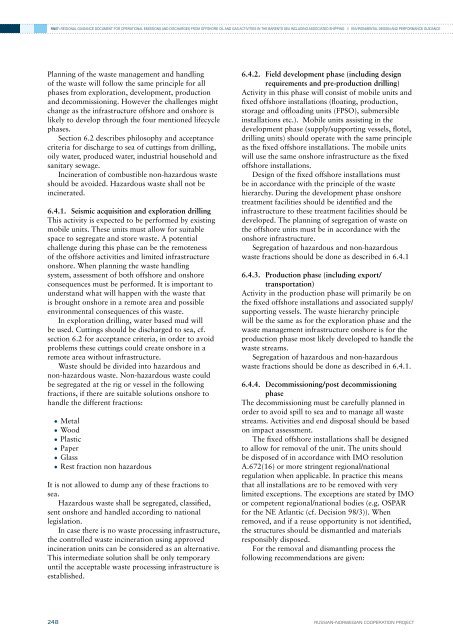phase 4 report - DNV
phase 4 report - DNV
phase 4 report - DNV
Create successful ePaper yourself
Turn your PDF publications into a flip-book with our unique Google optimized e-Paper software.
RN07: REGIONAL GUIDANCE DOCUMENT FOR OPERATIONAL EMISSIONS AND DISCHARGES FROM OFFSHORE OIL AND GAS ACTIVITIES IN THE BARENTS SEA INCLUDING ASSOCIATED SHIPPING // Environmental design and performance guidancePlanning of the waste management and handlingof the waste will follow the same principle for all<strong>phase</strong>s from exploration, development, productionand decommissioning. However the challenges mightchange as the infrastructure offshore and onshore islikely to develop through the four mentioned lifecycle<strong>phase</strong>s.Section 6.2 describes philosophy and acceptancecriteria for discharge to sea of cuttings from drilling,oily water, produced water, industrial household andsanitary sewage.Incineration of combustible non-hazardous wasteshould be avoided. Hazardous waste shall not beincinerated.6.4.1. Seismic acquisition and exploration drillingThis activity is expected to be performed by existingmobile units. These units must allow for suitablespace to segregate and store waste. A potentialchallenge during this <strong>phase</strong> can be the remotenessof the offshore activities and limited infrastructureonshore. When planning the waste handlingsystem, assessment of both offshore and onshoreconsequences must be performed. It is important tounderstand what will happen with the waste thatis brought onshore in a remote area and possibleenvironmental consequences of this waste.In exploration drilling, water based mud willbe used. Cuttings should be discharged to sea, cf.section 6.2 for acceptance criteria, in order to avoidproblems these cuttings could create onshore in aremote area without infrastructure.Waste should be divided into hazardous andnon-hazardous waste. Non-hazardous waste couldbe segregated at the rig or vessel in the followingfractions, if there are suitable solutions onshore tohandle the different fractions:• Metal• Wood• Plastic• Paper• Glass• Rest fraction non hazardousIt is not allowed to dump any of these fractions tosea.Hazardous waste shall be segregated, classified,sent onshore and handled according to nationallegislation.In case there is no waste processing infrastructure,the controlled waste incineration using approvedincineration units can be considered as an alternative.This intermediate solution shall be only temporaryuntil the acceptable waste processing infrastructure isestablished.6.4.2. Field development <strong>phase</strong> (including designrequirements and pre-production drilling)Activity in this <strong>phase</strong> will consist of mobile units andfixed offshore installations (floating, production,storage and offloading units (FPSO), submersibleinstallations etc.). Mobile units assisting in thedevelopment <strong>phase</strong> (supply/supporting vessels, flotel,drilling units) should operate with the same principleas the fixed offshore installations. The mobile unitswill use the same onshore infrastructure as the fixedoffshore installations.Design of the fixed offshore installations mustbe in accordance with the principle of the wastehierarchy. During the development <strong>phase</strong> onshoretreatment facilities should be identified and theinfrastructure to these treatment facilities should bedeveloped. The planning of segregation of waste onthe offshore units must be in accordance with theonshore infrastructure.Segregation of hazardous and non-hazardouswaste fractions should be done as described in 6.4.16.4.3. Production <strong>phase</strong> (including export/transportation)Activity in the production <strong>phase</strong> will primarily be onthe fixed offshore installations and associated supply/supporting vessels. The waste hierarchy principlewill be the same as for the exploration <strong>phase</strong> and thewaste management infrastructure onshore is for theproduction <strong>phase</strong> most likely developed to handle thewaste streams.Segregation of hazardous and non-hazardouswaste fractions should be done as described in 6.4.1.6.4.4. Decommissioning/post decommissioning<strong>phase</strong>The decommissioning must be carefully planned inorder to avoid spill to sea and to manage all wastestreams. Activities and end disposal should be basedon impact assessment.The fixed offshore installations shall be designedto allow for removal of the unit. The units shouldbe disposed of in accordance with IMO resolutionA.672(16) or more stringent regional/nationalregulation when applicable. In practice this meansthat all installations are to be removed with verylimited exceptions. The exceptions are stated by IMOor competent regional/national bodies (e.g. OSPARfor the NE Atlantic (cf. Decision 98/3)). Whenremoved, and if a reuse opportunity is not identified,the structures should be dismantled and materialsresponsibly disposed.For the removal and dismantling process thefollowing recommendations are given:248RUSSIAN–NORWEGIAN COOPERATION PROJECT






![Risk Based Pipeline Integrity Management [Compatibility Mode] - DNV](https://img.yumpu.com/50424229/1/190x146/risk-based-pipeline-integrity-management-compatibility-mode-dnv.jpg?quality=85)









